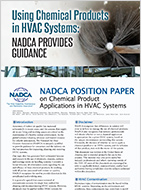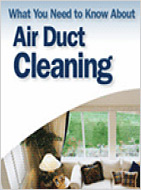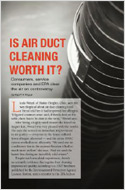Consumer Resources
FAQ's I Consumer Videos I Consumer Brochures
FAQ's:
Human skin scale and dander, insect & rodent feces and remains, allergens, dust mites, construction debris, pet hair and dander. Your family may be inhaling these contaminants every time your heating and cooling system turns on. If other people have lived in your home before you, you may also be breathing in these same contaminants that came from them. You may also need to have your system cleaned if you are getting a new furnace, have smokers in your home, have pets, recently remodeled, or haven't had your system cleaned in at least 3 years.
There are different methods of detecting if the system needs cleaning.
- Look on your furnace for a sticker from an air duct cleaning company. Most will have stickers they apply to your furnace upon completion of a cleaning to indicate when it was last done. If it has been 3 years or more, it may need to be cleaned again.
- Another method is to open a vent from any room in the house and shine a flashlight in it and use a mirror to see down the duct; if you see a film of dust/debris then it's time to clean your system.
- When you change your filter does is re-accumulate with dirt and debris at a more rapid pace than normal to your system in the past? If so this is an indication that your system is dirty.
- Finally, when the system is running does debris come out of vents? That would also be an indication that it's time to get your system cleaned.
YES!! Majority of brand new homes have a lot of leftover construction debris from the building of your home. Things like sheetrock dust, sawdust, nails, wood pieces, dirt and yes even pop cans and other garbage. The sheetrock dust can quickly plug your evaporator coil causing it to have to work harder to get the air through it so your HVAC system can heat or cool your home. This will increase your energy bills. Worst yet it could cause your system to seize up. Signs that your new system is in need of a cleaning include:
- White or grey dust on surfaces and electronics.
- Insulation and debris coming out of vents.
- Floor vents with construction debris in them.
You may be surprised to learn about the health problems and resulting quality of life concerns that are affected by what you breathe into your body. The EPA has determined that the air in your home or commercial building (work) is often 60-70% more polluted than the outdoors. We spend 60-90% of our time every day indoors between home and work. Plus, today's efficient, airtight homes and commercial buildings are excellent at conserving energy, but that also makes them better at trapping potentially irritating particles inside. With the rising number of people who suffer from allergies and asthma, indoor air quality has become more and more important to our general health and well-being.
Heating, ventilation, and air conditioning (HVAC) systems have been shown to act as a collection source for a variety of contaminants that have the potential to affect health, such as mold, fungi, bacteria, and very small particles of dust. The removal of such contaminants from the HVAC system and home should be considered as one component in an overall plan to improve indoor air quality.
Yes. Consider that the average home generates 40 pounds of dust for every 1500 square feet of space. Although you may vacuum on a regular basis and even contact vacuum in your registers, there is still so much of your system that is not clean and every time your system turns on, what remains may enter your clean living space. Just think about how often you change your vacuum bag or empty your canister after vacuuming your floors. This same dirt and debris also drops down your vents as well, however it accumulates through your system and eventually it needs to be "emptied" as well.
(BF Power Vac recommends these steps in order and preferably all in the course of one day)
- Thorough dusting of all surfaces and moping of all hard floors.
- Clean all bed linens and contact vacuum or have window treatments cleaned.
- Have your furnace and air ducts cleaned and install a new filter upon completion of cleaning.
- Have your carpets and upholstery professionally cleaned.
This is what BF Power Vac recommends for anyone who is trying to make the indoor air they breathe as healthy as possible. However, it is nearly impossible to keep dust completely out of your home, as every time you open a door or a window, dust/pollen comes in. We also track it in on our shoes as we enter our homes.
Research by the U.S. EPA has demonstrated that HVAC system cleaning may allow systems to run more efficiently by removing debris from sensitive mechanical components. Clean, efficient systems are less likely to break down, have a longer life span, and generally operate more effectively than dirty systems.
The most effective way to clean air ducts and ventilation systems is to employ Source Removal methods of cleaning. This requires a contractor to place the system under negative pressure, through the use of a specialized, powerful vacuum. While the vacuum draws air through the system, devices are inserted into the ducts to dislodge any debris that might be stuck to interior surfaces. The debris can then travel down the ducts to the vacuum, which removes it from the system and the home.
Frequency of cleaning depends on several factors, not the least of which is the preference of the home owner. Some of the things that may lead a home owner to consider more frequent cleaning include:
- Smokers in the household.
- Pets that shed high amounts of hair and dander.
- Water contamination or damage to the home or HVAC system.
- Residents with allergies or asthma who might benefit from a reduction in the amount of indoor air pollutants in the home's HVAC system.
- After home renovations or remodeling.
- Prior to occupancy of a new home.
The Environmental Protection Agency says that "duct cleaning services typically – but not always – range in cost from $450 to $1000 per heating and cooling system, depending on the services offered, the size of the system to be cleaned, system accessibility, climactic region, and level of contamination" and type of duct material. Commercial clients are recommended to contact a NADCA Certified Ventilation Inspector (CVI) and/or a NADCA certified cleaning contractor to attain pricing for commercial buildings.
Consumers should beware of air duct cleaning companies that making sweeping claims about the health benefits of duct cleaning – such claims are unsubstantiated. Consumers should also beware of "blow-and-go" air duct cleaning companies. These companies often charge a low fee and do a poor job of cleaning the heating and cooling system. These companies may also persuade the consumer into unneeded services with and/or without their permission.
(If you have knowledge of a practicing "blow-and-go" air duct cleaner, contact the Better Business Bureau to report the company.)
Don't jeopardize your family's health by using an inexperienced, unqualified provider. According to the EPA an improper cleaning can actually make indoor air quality worse.
- Make sure the company is a member in good standing of the National Air Duct Cleaners Association (NADCA).
- See if the company has been in business long enough to have adequate experience.
- Inquire whether the company is in good standing with the local Better Business Bureau.
- Get proof that the company is properly licensed and adequately insured.
- Verify that the company is certified by NADCA to perform HVAC system cleaning.
- Make sure that the company is going to clean and visually inspect all of the air ducts and related system components to insure cleanliness.
- Avoid advertisements for "$149 whole house specials" and other sales gimmicks.
- Ask if the company has the right equipment to effectively perform cleaning, and if the company has done work in homes similar to yours.
- Get references from neighbors if possible.
NADCA Members have signed a Code of Ethics stating they will do everything possible to protect the consumer, and follow NADCA Standards for cleaning to the best of their ability. Air duct cleaning companies must meet stringent requirements to become a NADCA Member. Among those requirements, all NADCA Members must have a certified Air Systems Cleaning Specialist (ASCS) on staff, who has taken and passed the NADCA Certification Examination. Passing the exam demonstrates extensive knowledge in HVAC design and cleaning methodologies. ASCS's are also required to further their industry education by attending seminars in order to maintain their NADCA certification status.
The amount of time it takes to clean a residential HVAC system depends on many variables such as the size of the home, the number of systems, the extent of the contamination and the number of HVAC cleaners performing the job. A typical home with 12 vents and a furnace in the garage can take one cleaner 3-6 hours and two cleaners 2½ - 4 hours.
The best way to determine if the HVAC system cleaning was effective is to perform a visual inspection of the system before and after cleaning. If any dust or debris can be seen during the visual inspection, the system should not be considered cleaned. While you can perform your own visual inspection using a flash light and mirror, a professional cleaning contractor should be able to allow you better access to system components and perhaps the use of specialized inspection tools.









